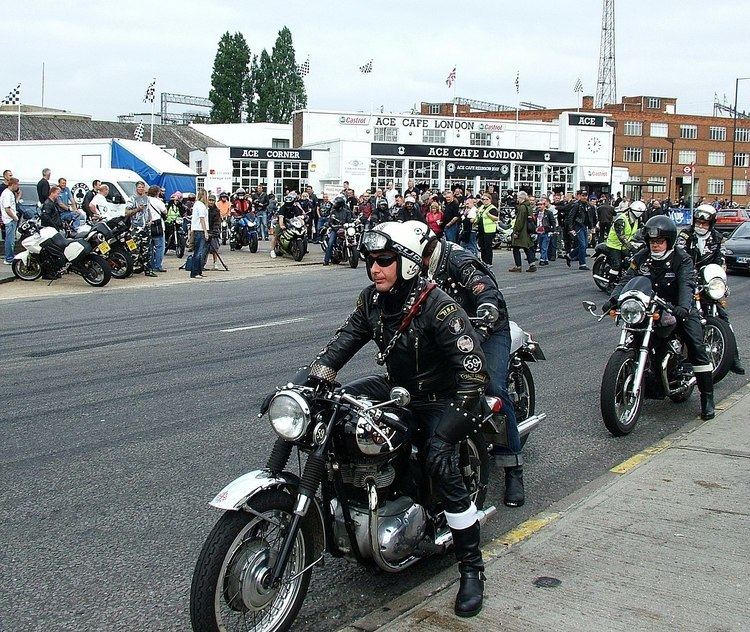 | ||
A café racer (/ˈkæf reɪsər/ KAF-ray-sər or more commonly /ˈkæfeɪˌreɪsər/ KA-fei-RAY-sər) is a lightweight, lightly powered motorcycle optimized for speed and handling rather than comfort – and for quick rides over short distances. With bodywork and control layout recalling early-1960s Grand Prix road racing motorcycles, café racers are noted for their visual minimalism, featuring low-mounted handlebars, prominent seat cowling and elongated fuel tank – and frequently knee-grips indented in the fuel tank.
Contents
Café racer origins
In 2014, journalist Ben Stewart described the café racer as a "look made popular when European kids stripped down their small-displacement bikes to zip from one café hangout to another."In 1973, American freelance writer Wallace Wyss, contributing to Popular Mechanics magazine, wrote that the term café racer was originally used derogatorily in Europe to describe a "motorcyclist who played at being an Isle of Man road racer" and was, in fact, "someone who owned a racy machine but merely parked it near his table at the local outdoor cafe."The term developed among British motorcycle enthusiasts of the early 1960s from Watford, and London, specifically the Rocker or "Ton-Up Boys" subculture, where the bikes were used for short, quick rides between cafés, in Watford at the Busy Bee café and the Ace Café in London. In post-war Britain, car ownership was still uncommon, and for many, the motorcycle, often with a sidecar, was the family vehicle. By contrast, the café racer's significance was that a bike had come to represent speed, status and rebellion, rather than mere inability to afford a car.
Configuration
In addition to light weight, a tuned engine and minimalist bodywork, the café racer typically features distinctive ergonomics. Dropped bars that are low, narrow handlebars called clip-ons – enabled the rider to "tuck in", reducing wind resistance and improving control. Along with the rearward located seat, the posture often required rearsets, or rear-set footrests and foot controls, again typical of racing motorcycles of the era. Distinctive half or full race-style fairings were sometimes mounted to the forks or frame.
The bikes featured minimalist styling, engines tuned for maximum speed and light road handling. A well-known example was "The Triton", a homemade combination of the Norton Featherbed frame and a Triumph Bonneville engine. It used a common and fast racing engine combined with a well-handling frame, the Featherbed frame by Norton Motorcycles. Another hybrid was the "Tribsa" which had a Triumph engine in a BSA frame. Other combinations such as the "Norvin" (a Vincent V-Twin engine in a Featherbed frame) and racing frames by Rickman or Seeley were also adopted for road use.
Evolution
Café racer styling evolved throughout the time of their popularity. By the mid-1970s, Japanese bikes had overtaken British bikes in the marketplace, and the look of real Grand Prix racing bikes had changed. The hand-made, frequently unpainted aluminium racing fuel tanks of the 1960s had evolved into square, narrow, fibreglass tanks. Increasingly, three-cylinder Kawasaki two-strokes, four-cylinder four-stroke Kawasaki Z1, and four-cylinder Honda engines were the basis for café racer conversions. By 1977, a number of manufacturers had taken notice of the café racer boom and were producing factory café racers, such as the well-received Moto Guzzi Le Mans and the Harley-Davidson XLCR. A special version of the Honda XBR thumper with wire-spoked wheels, the Honda GB500 TT, sought to emulate BSA and Norton café racers of the 1960s.
In the mid-1970s, riders continued to modify standard production motorcycles into so-called "café racers" by simply equipping them with clubman bars and a small fairing around the headlight. A number of European manufacturers, including Benelli, BMW, Bultaco and Derbi produced factory "café" variants of their standard motorcycles in this manner, without any modifications made to make them faster or more powerful, a trend that continues today.
Modern café racers
Manufactures have noticed that there is a lot of consumer interest in café racers. For 2017 there are a number of Manufacture model café racers for sale. Triumph has two models for sale the Thruxton and the Street Cup, BMW has the R nine T Racer, Ducati has the Scambler Café Racer, and Yamaha has the XSR900 Abarth, Harley-Davidson has the XL1200CX Roadster.
Subculture
Rockers were a young and rebellious rock and roll subculture who wanted a fast, personalised and distinctive bike to travel between transport cafés along the newly built arterial motorways in and around British towns and cities. Biker lore has it that the goal of many was to be able to reach 100 miles per hour (160 km/h)—called simply "the ton"—along such a route where the rider would leave from a café, race to a predetermined point and back to the café before a single song could play on the jukebox, called record-racing. However, author Mike Seate contends that record-racing is a myth, the story having originated in an episode of the BBC Dixon of Dock Green television show. Café racers are remembered as being especially fond of rockabilly music and their image is now embedded in today's rockabilly culture.
The Café Racer sub-culture has created a separate look and identity with modern café racers taking style elements from American Greasers, British Rockers, 70s bikers, and modern motorcycle riders to create a global style of their own.
